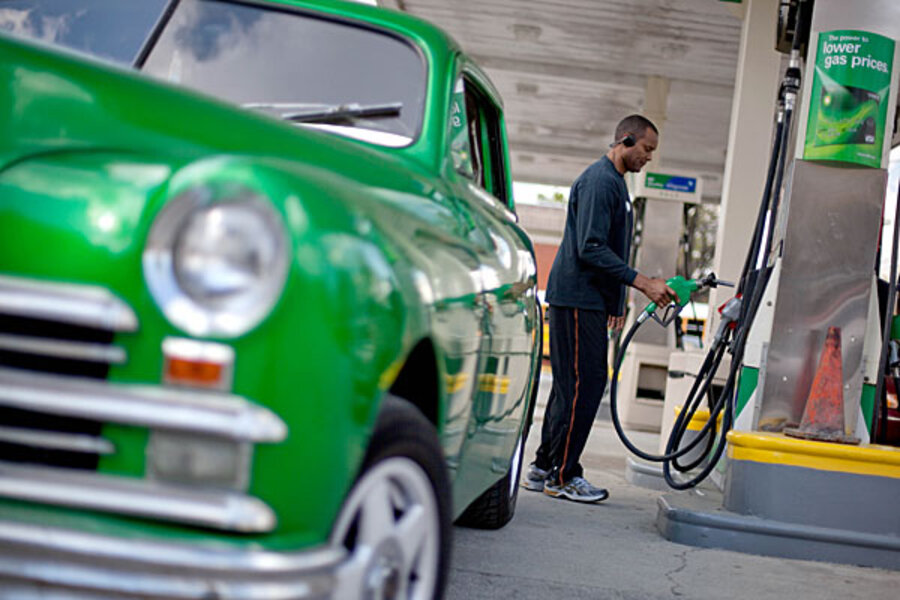Is $3 a gallon a historical relic? What could bring gas prices back to earth.
Loading...
| New York
The last time the price of gasoline was below $3 a gallon was just before Christmas in 2010.
What would it take to get the price at the pump down from its current level of $3.83 a gallon to what it cost fifteen months ago?
The short answer is that gas prices that low might be possible if several factors came together, such as Americans switching to more fuel-efficient vehicles, a slowing of the economy, or resolution of the crisis over Iran’s nuclear program.
Avery Ash, director of government affairs for AAA and an expert on the gasoline market, estimates fear of a conflict in the Middle East adds as much 60 cents a gallon to the price at the pump in those areas that are supplied by crude priced on the global market.
“Resolve that issue – and remove the current risk premium in the market – and you have a scenario where there could be significant downward pressure on global prices,” says Mr. Ash.
Reducing or at least slowing the increase in the price of gasoline has suddenly taken on a larger importance, both politically and economically.
On Thursday, President Obama tried to address the issue in part by disagreeing with Republicans who are attacking him for not allowing enough drilling for new oil supplies. Obama said drilling is at record levels. But the president noted that US oil reserves are limited compared to US consumption.
“There’s no such thing as a quick fix when it comes to high gas prices,” Obama said in a speech at Prince George’s County Community College in Largo, Md. “We know there’s no silver bullet.”
Absent a fix, the rising price of gasoline is impacting the US economy by draining money from Americans’ pockets. On Friday, the government reported that the February Consumer Price Index rose 0.4 percent, in large part because of rising gasoline prices. In March, prices have continued to move higher.
One indication of political angst: Obama and UK Prime Minister David Cameron discussed releasing oil from the Strategic Petroleum Reserve when they met. Reportedly, they made no decision.
Prices rose sharply last spring as well when the civil war in Libya disrupted oil supplies. Then, Obama released oil from the Strategic Petroleum Reserve before the conflict turned in favor of the rebels.
Oil prices fell from $113 a barrel on April 29 to $97 a barrel by May 6. By October, oil was selling for $75 a barrel. “That’s a decrease of over $30 a barrel,” says Mr. Ash. “For every $1 a barrel decrease, the price at the pump comes down 2. 5 cents a gallon so that’s a 75 cent per gallon decrease.”
Another factor that could lower the price of oil and gasoline is if the economy were to slow or even go back into a recession. In December of 2007, the official start of the recession, the price of oil was $98 a barrel and gasoline was selling at $2.81 a gallon (not adjusted for inflation). By the end of the recession, in June of 2009, the price of oil had fallen to $59 a barrel and gasoline was selling for $2.35 a gallon.
“If demand weakens for oil, that may mean bad news for everyone,” says Sandar Cohan, an energy analyst at Energy Security Analysis, Inc. in Wakefield, Mass. “It may mean we are not doing well in the economy.”
However, as Mr. Cohan also notes, demand has already weakened while prices have not. Gasoline demand is off about 6 percent to 7 percent compared to a year ago. “You would expect a much lower gasoline prices at this level of demand,” he says.
One of the reasons prices at the pump have stayed high, he says, is concern over moving gasoline from the refineries on the Gulf Coast to East Coast markets this summer. “There is plenty of gasoline,” he says, “There is plenty of supply on the Gulf Coast, but the issue is getting it to the markets.”
In 2013 moving gasoline to the eastern seaboard will be somewhat easier because the Colonial Pipeline, the main artery for moving gasoline, will be expanded. “Until then you will have to find other more expensive ways to move it, such as by barge or truck,” says Cohan.
To the oil industry and many of the Republican candidates, the solution is simple: open up federal lands for more drilling. The Institute for Energy Research, which has disagreed with Obama on energy policy for some time, says oil and gas production declined on federal lands last year.
"Why the president prefers to create jobs in Riyadh and Mecca rather than in Mobile and Pascagoula defies understanding,” said Thomas Pyle, president of the Institute, in a statement on Thursday.
Energy economist Chris Lafakis of Moody’s Analytics.com thinks the price of gasoline could ultimately come down significantly if the nation were to develop a national energy policy. “In the long term it would be most effective if we could reduce our reliance on foreign oil and reduce US consumption of oil,” says Mr. Lafakis.
However, instead of more drilling, Mr. Lefakis thinks the best way to lower reliance on foreign oil is through conservation. He says since oil is mainly used for transportation, making vehicles more efficient or offering vehicles with alternative fuels such as natural gas or electricity would help.
If gasoline were to fall below $3 a gallon, Lafakis would prefer to see additional taxes to insure Americans did not go back to using gas-guzzlers.







